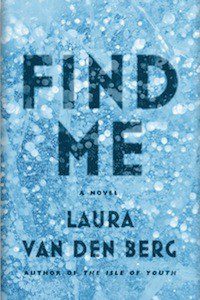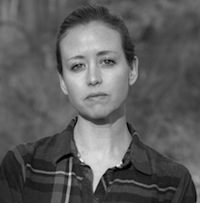
There are certain alluring songs that express a loneliness so aching and stark and beautiful, you want to do nothing but ignore the outside world and lie on your bed and listen to them over and over again. Bon Iver is full of such songs—wintry songs, prehistoric songs, songs out of time. Nick Drake’s Pink Moon is another. You might have a million things to do, but you keep hitting repeat, you keep sending yourself back into that lonely world willingly. The paradox of these loneliness albums is that, if you are of a certain disposition, you feel less lonely and more alive after listening to them, and this is why you’re willing to let them consume you. Rarely does a bleak novel achieve the same alluring strength of sadness. Laura van den Berg’s debut novel Find Me is that rare novel. It has the same potency as the most melancholy music.
The novel takes place in a not-too-distant post-apocalyptic future. A lethal epidemic has swept the nation—a disease that begins with memory loss and silver blisters on the skin. The ironically named Joy Jones is a grocery store clerk working in Massachusetts when the epidemic starts. Abandoned by her mother in winter when she was a baby, Joy grew up in foster care and group homes. She is haunted by the original abandonment and by a series of disturbing events, some of which are shrouded in the mysteries of memory. Joy is the sort of person who stands in the produce aisle on her birthday, “skin dewy from the vegetable misters,” asking “Why did I choose to be this?”
In an art museum watching a video of a woman wearing antlers, Joy wants to ask the woman what “it would feel like to not carry such division within, because to look inside yourself and see so much mystery is the worst kind of loneliness.” As a doctor later notes, secrecy is her natural state, including the secrets she keeps from herself.
Joy seems to have a single advantage. She is one of a small group of people who are immune to the memory disease. Although she is exposed, she soldiers on, drugging herself to sleep each night by drinking cherry-flavored Robitussin.
Joy’s aunt is succumbing to the epidemic. She summons Joy to the hospital, and she shares her memories with Joy, along with a Polaroid of Joy’s biological mother. Shortly afterward, Joy is invited to a former state psychiatric hospital in Kansas where doctors claim to be studying those who are immune to the disease in order to find a cure. She shares a room with a young man named Louis. In their group are two twins. Pilgrims appear outside the hospital windows. While watching television at the hospital Joy realizes that her mother, the woman in the Polaroid, is an undersea archeologist who hosts a television show called Mysteries of the Sea. She begins to research who her mother is, and to imagine where she comes from, and what her identity might be.

The first half of the novel shifts between the present and flashbacks, exploring time and memory. There are loose threads, odd remarks and events that are never fully explained or resolved. Characters appear and disappear as they do in life, without handing us their reason for coming or going. But the key mysteries, carefully mapped in the first half, are satisfyingly wrapped up in the end.
The physical reality of Joy’s world in the first half is grounded in plausible but slightly askew details that point to a larger post-apocalyptic reality. It’s like being seduced into belief during a dream: the Kool-Aid-like red dust at the bottom of a glass, a hair dye called Chocolate Cherry, the menacing son of one of the foster families who wears shirts the color of the sea. In flashbacks, there are hints of the surreal—a dream fog—that will eventually drive the novel.
The dream qualities are intensified in the second half of the novel when Joy goes on a quest to find her mother in Florida. From Kansas, she journeys east by bus, across an America of seedy motels, gas stations, desperate itinerant people and an unexpected, tender figure from her past. The sensual details in the second half become increasingly sinister: a cardboard core of a toilet paper roll soaked in blood, hotel rooms that smell like chlorine even though there’s no swimming pool nearby. It’s the physicality of van den Berg’s prose, the believability of the individual details not quite adding up to our world, that keeps the uncanny, just-off-kilter novel from spilling over, from turning into the kind of magic psychosis that Murakami often delights in.
In Find Me, van den Berg brings together a number of the elements of her memorable short stories in The Isle of Youth and What the World Will Look Like When All the Water Leaves Us. Readers of those collections will notice her continued fascination with broken young women protagonists, orphans, rubber masks, acrobats and quests. There is the occasional grim humor (wearesorryforyourloss.com provides a list of the people who have died from the epidemic), and there is, of course, her mesmerizing, beautiful prose style. In both short story collections, van den Berg’s writing is just at the precipice of surrealism. We know that her world of sister detectives, gangs of kids that robs banks, and a woman seeking her dead brother in Antarctica, is not quite our world, but it’s hard to pinpoint why they couldn’t be. Find Me steps further off that cliff.
In addition to her clean, beautiful prose voice—a voice that makes you want to follow it anywhere—van den Berg has an urge as a writer that feels unusual in contemporary literary fiction: her stories have plots. Like her short stories, the novel borrows from the addictive properties of genre fiction and mainstream television. Surprising events happen in Find Me—there are inset stories, sinister characters, trouble lurking everywhere—but van den Berg’s ability to render all of them with a high degree of psychological realism gives these twists and turns a degree of inevitability. Find Me has a psychological depth and a desolate, noirish gravity. The whole shimmering novel hangs together and propels the reader forward with its unusual brand of dream logic.
The novel starts: “Things I will never forget: my name, my made-up birthday, the rattle of a train in a tunnel.” By the time I closed the book, I knew Find Me‘s spectral visions of America would haunt me, and I knew I would want to read it again.




